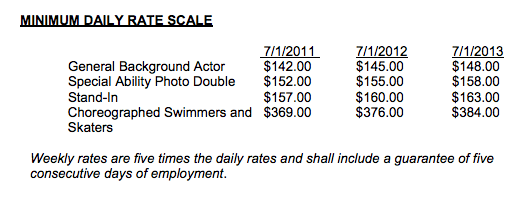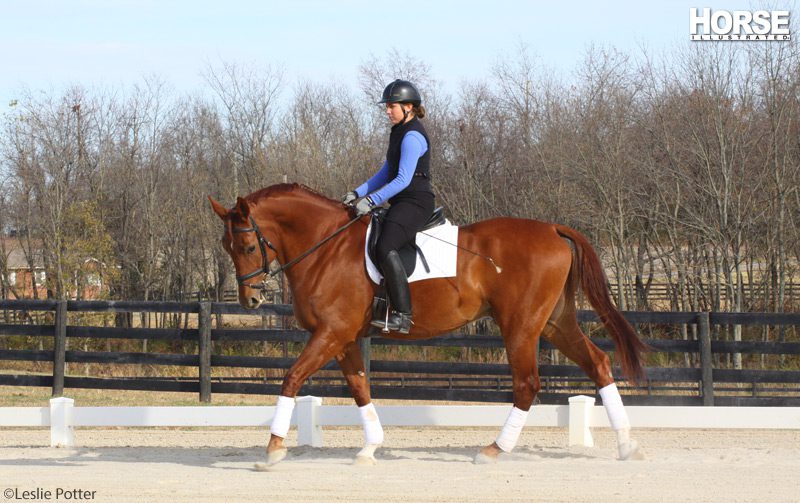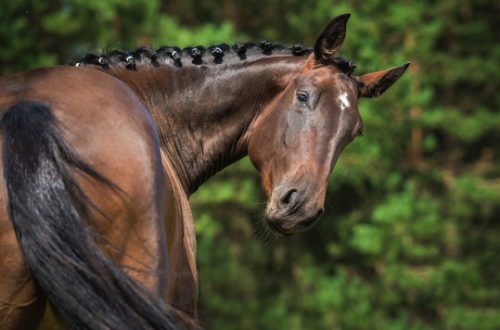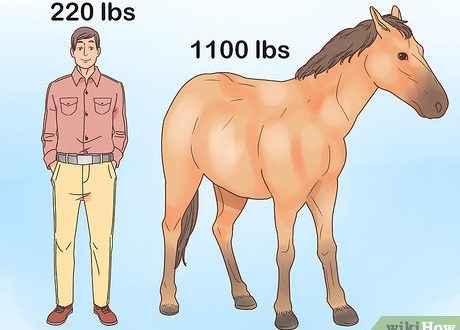
Seven Problems of the Horse “Under the Top” and How to Fix Them
Seven Problems of the Horse “Under the Top” and How to Fix Them
No horse is born with the ability to understand and correctly respond to the aids of the rider. Bad habits, poor physical condition, lack of proper training, and work under the wrong rider can cause problems for the horse when working under the saddle.
Below, we will look at the most common problems and offer tips and exercises to fix them.

The horse that doesn’t want to slow down
Many riders have encountered hot horses that just want to “run” and ignore any request for a more chalked ride.
To solve this problem, it is worth trying to work on transitions – multiple descending transitions between gaits, and then within the gaits. (For more on transitions, see here – adj. ed.).
One can start with transitions from a step to a stop and progress to transitions to a stop with lynx. If you find it difficult to transition on a large circle or on a long wall, try transitioning on a smaller circle until your horse is better at listening to your aids.
If the horse is very strong, it can be difficult to stop him after he has gone all the way through the long wall, so it is best to start at the trot in a small circle and ask for a halt in it, or when working on the long wall, stop at a walk. Ideally, you want to get the horse to make a transition in response to the seat command, you should not have a lot of hands, you should not tug on the rope. The more transitions you do correctly, the easier it will be for you.
A horse that doesn’t move forward
The opposite of a hot horse is a “real estate” horse, which has to be constantly “kicked” with its legs to keep it moving forward. It is necessary to stop working with shanks, and such a horse stops. Often all this suggests that the horse is behind the legs, behind the controls.
Start from a stop, put your legs on the sides of the horse. If the horse does not want to go from a light impact, send him out harder. If there is no response, add a whip to convey your demand.
Once you get the desired response, praise the horse and then ask him to respond to your controls again using the same systematic approach. The horse must understand that if he does not respond to a light signal, he will receive a stronger one.
When working with “real estate”, transitions will again come to your aid, but now you will need not descending, but ascending. Start working on transitions to trot from a walk or stop. Don’t punish a horse if it breaks into a gallop (that’s the worst thing to do)! If the horse starts to canter, bring him to a trot and praise him for moving forward. Work methodically! The key to success is repetition, to teach the horse to listen to the rider’s subtle commands.
enslaved horse
Some horses can be uncomfortable to sit on, and this is often due to their enslavement. As with naturally inflexible humans, these horses will benefit from stretching and developing their overall fitness.
Think about yoga for horses. Every horse is enslaved to some degree. What can help her? The very first thing that comes to mind is serpentines, large and small; circles; rides back through half-volts and work in counter canter (if the horse is familiar with counter canter).
It is desirable for such horses to give more time to step before training – they need more time to stretch their joints and warm up.
Try to work on the following exercises:
1. Serpentine in four loops
The basic exercise with which you warm up your horse is the four-loop serpentine. It is performed on a step, from one end of the arena to the other, the loops go from one long wall to the other. You can make this warm-up more enjoyable and varied by “winding” around the stable area outside the arena or parade ground before calling in there.
Bend your horse properly before starting the intense part of the workout.
If the horse does not bend easily, you must be careful. Don’t rely too much on the outside rein – soften it up a bit. Too hard on the outside rein can block the horse. But the rule “from the inside leg to the outside rein” has not been canceled – in this case, your inside rein is just performs a supporting function.
If you are riding a 20-meter circle, push the horse with your inside leg to the outside rein so that he becomes more flexible in the chest area. If the horse is leaning on the outside rein, bend it around your inside leg and support it with the inside rein, working it out and softening it up. Always make sure to work the same way in both directions.
2. Leg yield
The leg yield is one of the basic lateral exercises that can do wonders. It relaxes and liberates horses of any level of training. The horse should walk forward and sideways in approximately equal proportions, his body should remain parallel to the long walls of the arena, but the front should still be slightly ahead of the hindquarters. However, leg-yielding signals can bring the horse down. confusing, so you will need to serve them clearly to get her to cross her legs and loosen up her back.
If you are leg-yielding from left to right, your weight should be slightly more towards the right sitting bone and your right leg should be in a neutral position, lying softly on the horse’s side. Your left foot should be at the girth, pushing the horse to the right rein, and with the left rein you support the movement. (Here and here you can learn more about leg yielding – ed.).
3. Arrivals back
Another useful exercise to help loosen up a tethered horse is back riding.
Start working on the long wall. Raise your horse into a trot and move down to E. At E, ride back to change direction, returning to the wall at H (marking the arena).
The ride can be performed with a radius of 8 or 10 meters – depending on the ability of the horse. Sometimes riders start working on circles and get hung up on them. But I am convinced that it is necessary to get out of the circle from time to time!
You can change the ride back by leg-yielding back to the wall or starting at a canter and ending with a counter-canter (if your horse is familiar with this movement). By working in this way, you are trying to “force” the horse to become more supple laterally.
Too flexible horse
A enslaved horse is a problem. But it is no less a problem if your horse is too flexible. These horses bend their neck too much inward and drop out at the shoulder when you pick up the inside rein.
You can handle the situation by getting more contact on the outside rein. You will need to work on straightness by engaging your outside rein and leg.
If the horse falls out shoulder-to-shoulder, try to bring the shoulder back into place with the outside rein and leg. Leg yielding can also be helpful – if the horse starts to drop out shoulder-to-shoulder, take one or two steps straight to correct the problem.
Overworking the inside rein is a very common mistake riders make, especially when they are working the circle or making leg yields. To get the best contact on the outside rein, try riding with a counter-setting.
Don’t focus on turning your horse’s head and neck – “turn” his shoulders! Shift your horse’s shoulders to the left, moving both arms to the left as one unit, and shift your weight slightly towards the inside of the sitting bone. Think about how you move her shoulders with your shoulders and hips. If you quickly look down, your horse’s shoulders should not be out of the circle’s path. Try this first at the walk, then at the trot. This exercise will help you stop pulling on the inside rein and begin to control the outside rein a little more.
The horse follows the lead
Some horses avoid proper contact by moving their head over the vertical. Most often this is the result of inadequate training in the past.
Horses of this type will move behind the controls without engaging the hindquarters (hind legs) with your hands (contact). Here again the transitions will help you, but they will have to be done quickly – this will force the horse to put the weight on the hindquarters and raise the shoulders.
Horse with restless head or mouth
A restless head or mouth is one of the most difficult problems. You should start working on it with a physical examination of the horse. Your veterinarian will help you understand if it is related to the ill health of the horse.
If the examination shows that the health of the horse is good, it will be possible to think about whether the bit is suitable for the horse, and also to be critical of yourself as a rider – make sure that your arms and hands are not enslaved and you are not holding on to the horse’s mouth.
Horse that does not accept contact
Contact aversion by the horse is also a common problem. And here the rider will again have to think about himself. If the rider cannot stabilize his body, it will be difficult for him to establish constant contact with the horse. But I would like to see the rider’s contact as stable as the side reins, especially if the horse is restless and fidgety. As your horse’s head comes up, increase pressure starting at the elbow until he relaxes his neck.
Another way to work on contact is to imagine that you are holding the hand of a small child. If the child walks calmly next to you, you will have soft contact with his hand. If he tries to run away or break out, you quickly increase the pressure to get his attention, and then quickly relent. The same principle can be used with horses.
With persistence and a systematic approach, most horses can be improved. If something doesn’t work out for you, enlist the support of an experienced trainer / guard.
Reese Koffler-Stanfield(source); translation Valeria Smirnova.





